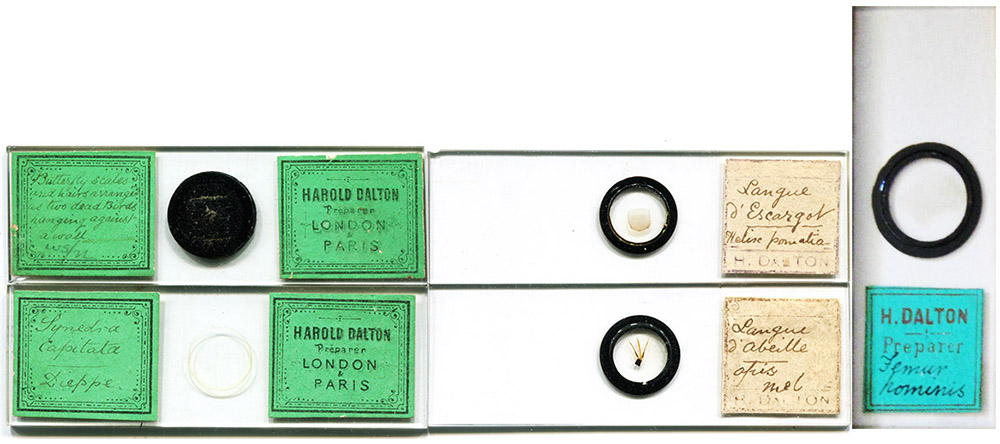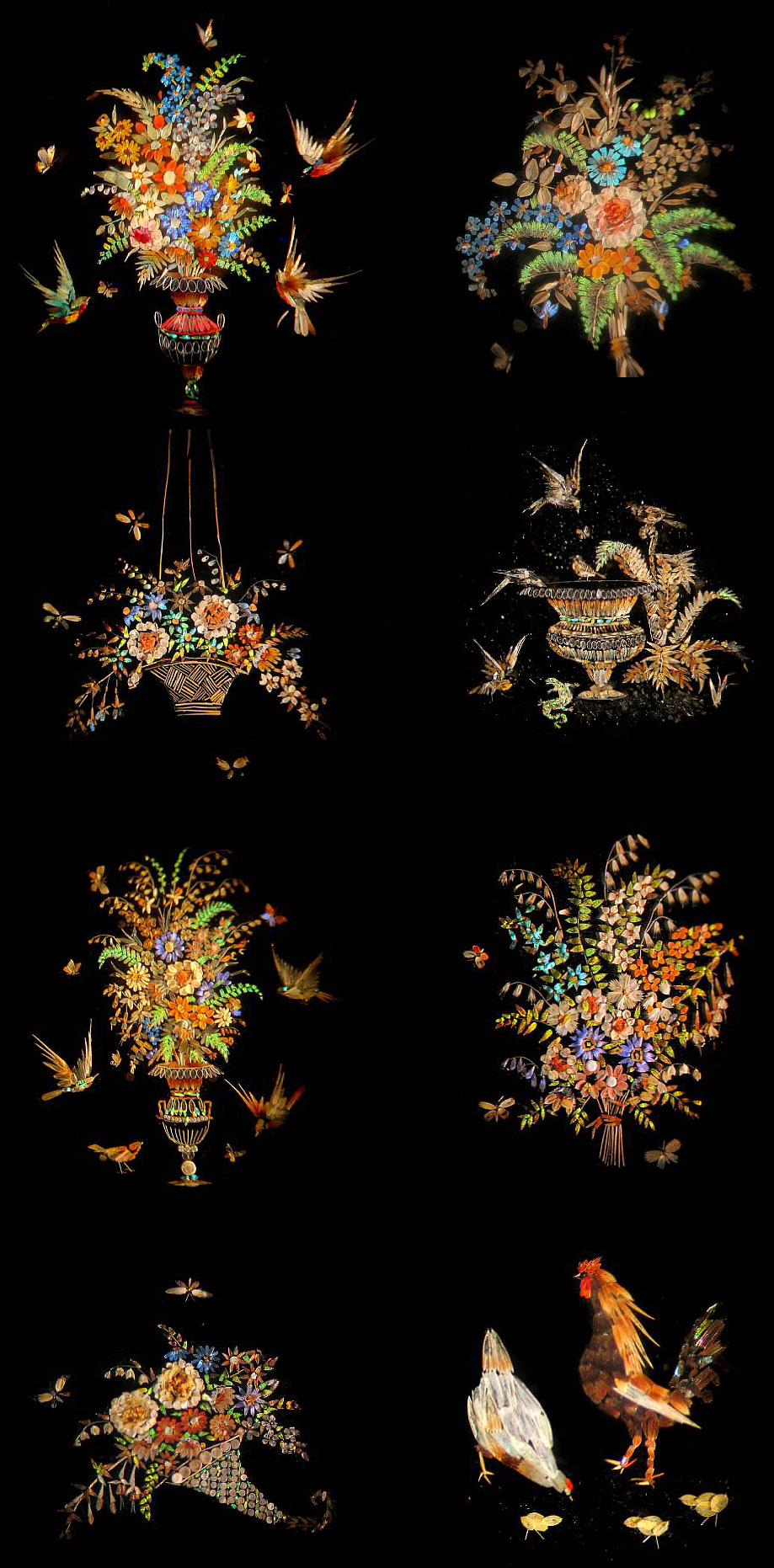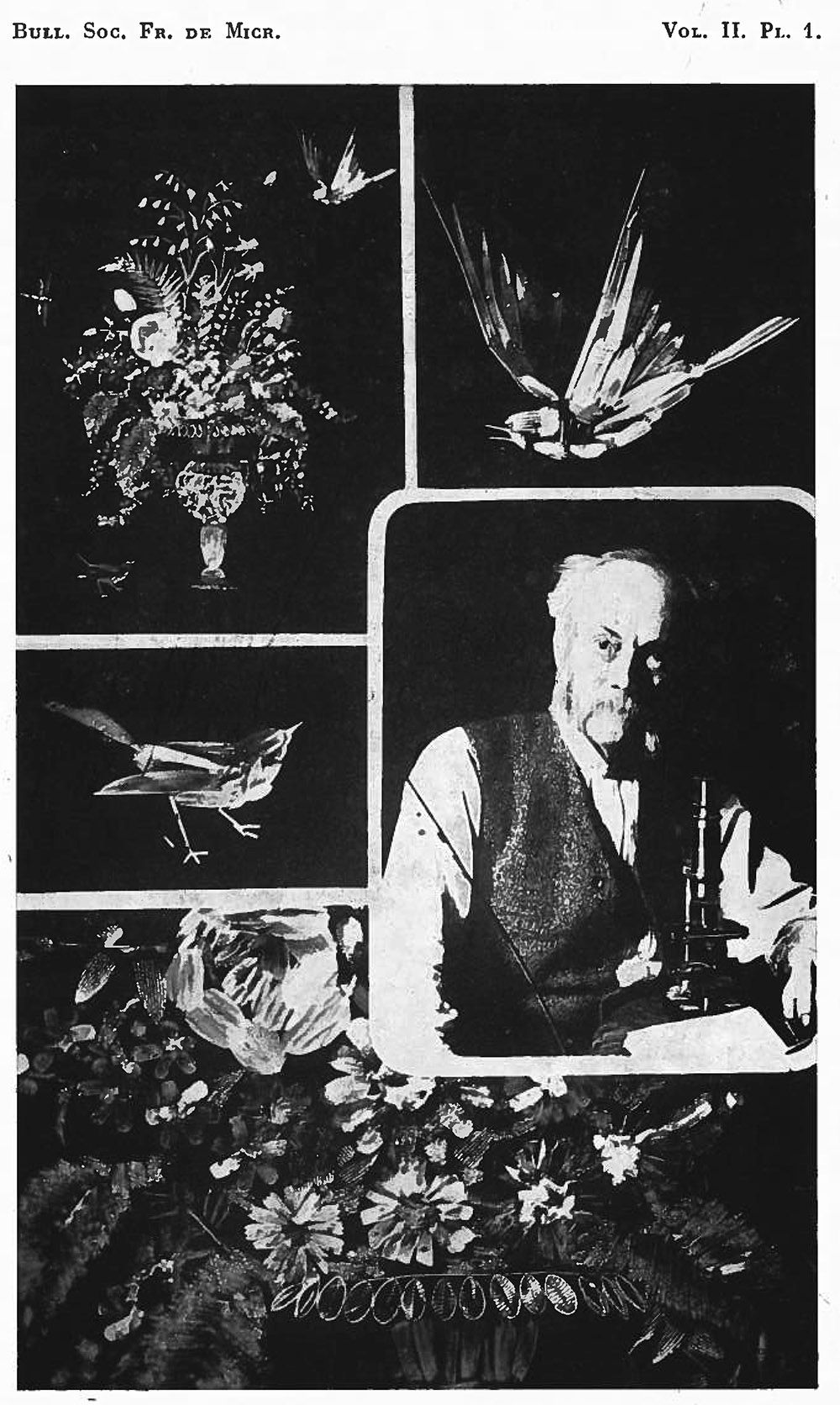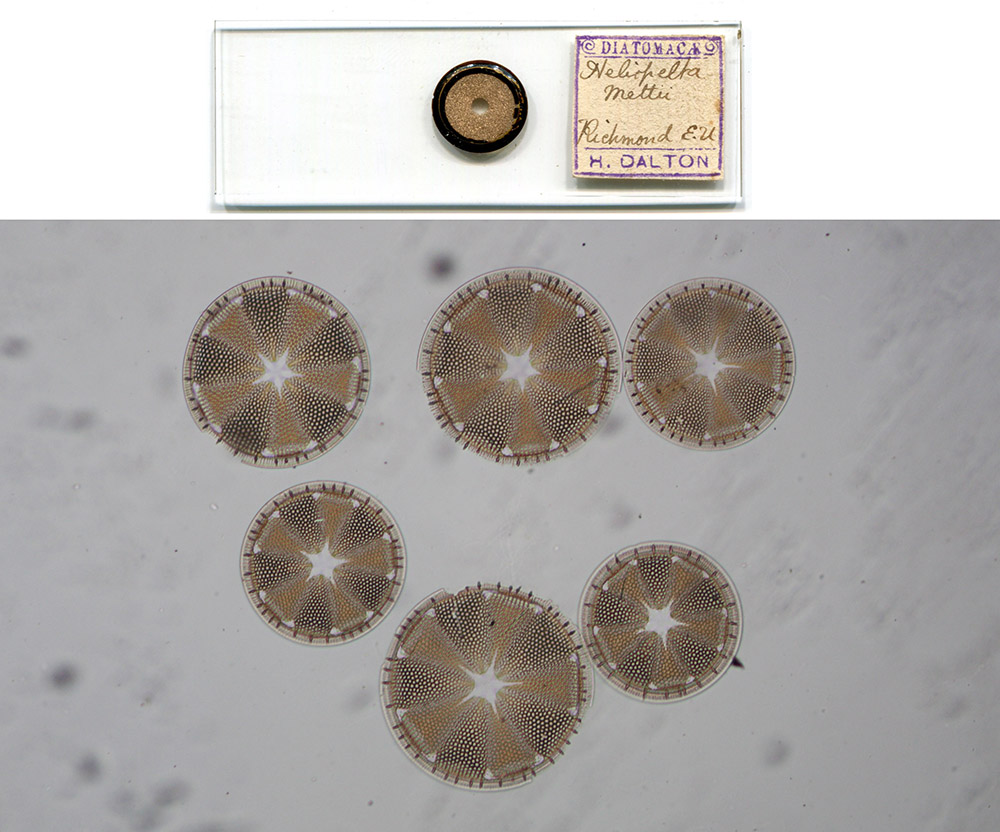Henry “Harold” Dalton, 1836-1912
by Brian Stevenson
last updated August, 2024
Dalton produced exquisite microscopic arrangements of butterfly scales and diatoms during the last quarter of the nineteenth century. Those colorful works of art often contain hundreds of individual pieces. Needless to say, they generally command very high prices nowadays.
Dalton also sold slides of diatom species, intended for scientific uses.
Additionally, he prepared slides of a wide variety of objects for his own amusement and education. Microscope slides from Dalton’s personal cabinet are occasionally seen, and share the high quality of his professional mounts.

Figure 1.
Microscope slides by Harold Dalton. The two on the left, with green labels, are examples of his professional mounts, the upper slide being an arrangement of butterfly scales and the lower containing a strew of Synedra capitata diatoms. Dalton worked from Paris for most of his career; the inclusion of London on his labels presumably indicates that he had a distributor in that city. The two slides in the middle and that on the right are of general microscopic interest (radula of a snail, bee’s mouthparts, and section of a human bone), and were probably prepared by Dalton for his own enjoyment and kept in his personal cabinet. Images are of slides from the author’s collection or adapted for nonprofit, educational purposes from internet auction sites.

Figure 2.
Examples of Harold Dalton’s arrangements of butterfly scales and diatoms. Adapted for nonprofit, educational purposes from an internet auction site.

Figure 3.
Photograph of Harold Dalton posing with a microscope, taken toward the end of his life. The four surrounding images are photomicrographs of his microscopic arrangements. From André Bayard’s 1932 biography of Dalton.
Dalton was given the name “Henry” at his birth. For an unknown reason, he adopted the name “Harold” for his professional slide-making business.
There has been confusion on the date of Dalton’s birth. André Bayard knew Dalton during Dalton’s last years of life, and when Bayard was a young man. In 1932, Bayard wrote a historical essay on Dalton, but confessed that his discussions with Dalton had centered on microscopy and that they never discussed the elder man’s life. To make up for that lack of knowledge, Bayard copied a 1911 article on Dalton’s life, written by Jules Magnin. Unfortunately, Magnin summed up Dalton’s early life in one brief sentence: “After strong general studies, where the sciences held the first rank, Dalton married and left England”. Bayard probably estimated Dalton’s birth date from a photograph that was incorrectly described as showing Dalton at 82 years old (Figure 3).
There is also a caveat to the reported year of Dalton’s death. Bayard wrote that Dalton died in November, 1912. Yet, he cited Magnin’s publication, which is obviously an obituary, and stated that Magnin published it in November, 1911. One of those dates must be erroneous - I am trying to track down a copy of Magnin’s paper to clarify this issue.
Henry Dalton was actually born in 1836, in Bury St. Edmunds, Suffolk, England. Records of his baptism and schooling attest to that date. His father, Rowland, was a surgeon and physician. Henry grew up in a well-attended household; in 1851, the family employed a cook, a groom, and two “servants” (presumably housemaids).
As a young man, Henry took work as a bank clerk, first in London and then in Liverpool. He married Susannah Denby on January 20, 1860, at the Parish Church of Islington (London). By March of the following year, they were in Liverpool, boarding with an unrelated family. The March, 1871 census shows that they were still lodging in the Liverpool area.
Soon afterward, the Daltons moved to the European continent and began a life of travelling. The scant records of Dalton’s life do not provide insights on the reasons behind his seemingly abrupt change from stolid bank clerk to wandering traveler. A recent web publication suggested that Dalton had contracted tuberculosis and moved to the Continent for his health. I have not found any contemporary reports to support that notion. At any rate, he and his wife lived until well into their 70s, so they do not appear to have been particularly hampered by ill health.
By 1875, Dalton had become well-known for his artistic microscope slides, on both sides of the Atlantic. In that year, Augustus de Souza Guimaraens wrote on “English and foreign preparers of microscopic specimens” for the Monthly Microscopical Journal, including Dalton among the foreign preparers: “H. Dalton's arranged scales are deservedly admired as ‘pretty and showy’ preparations”. Also in 1875, William H. Walmsley exhibited to the Philadelphia Academy of Natural Sciences “a resplendent slide of butterfly-scales arranged by Mr. Harold Dalton, of Havre, representing birds of brilliant plumage, around an iridescent vase”.
Walmsley’s display indicates that the Daltons were living in La Havre, France in 1875. Magnin’s biography of Dalton states that “he and his wife traveled to Holland and Belgium, stayed for some time in Paris during 1871, then continued on with long journeys, going from city to city throughout central Europe and Italy. His reputation as an eminent micrographer preceded him in the great centers where the naturalists impatiently awaited his fine preparations” (translated). The last sentence suggests that Dalton financed his travels by selling microscope slides as he moved from city to city.
Newspaper articles of the 1880s and 1890s falsely stated that Dalton was dead. The earliest of these that I located was from 1882, reported to be an interview with Ezra H. Griffith (1838-1894, inventor of the Griffith “Club” microscope): after examining “a slip of glass (that) contains the representation of a beautiful bouquet of flowers … eighty-two distinct flowers of various shades and colors, and each as perfect as it would be possible for an artist to represent it on canvas … made from the scales and hair of Brazilian butterflies”, Griffith said that the slide was made by “Harold Dalton, of London, who is now dead”. This tale was repeated, and expanded upon, over the years. An 1891 article from The Indianapolis Journal (USA) was written as if a local reporter had recently interviewed a visitor to that city, and concluded by describing a slide as “the work of a genius, Harold Dalton, an English microscopist who has had several imitators but not one to approach him in the beauty and delicacy of his work. He became dissipated; going to and from between London to Paris to avoid creditors. His life-work as a microscopic artist is ended”. Most of that 1891 article was plagiarized from the 1882 article, and the “interview” was undoubtedly fictitious. I did not find any records suggesting that Dalton was plagued by creditors.
Far from being dead, Dalton continued to produce microscope slides and gain in fame. A report of an 1885 exposition in Antwerp included, “The bouquets of Dalton offer the example of a similar skill; but here it is put to the service of an effect at once picturesque and artistic; he took advantage of the iridescent appearance due to a complex phenomenon (thin sections and networks) which gives rise to very bright colors; with the diatoms and scales of butterfly wings, bouquets of microscopic flowers have been composed, such as those made with elytra of insects; these preparations have had a great success of curiosity; we could not tire of admiring them” (translated).
Magnin and Bayard included some personal information on Dalton’s life in the 1880s: “Passing back through Paris, he found a childhood friend, Mr. Stern, the electrician who, with Swan, invented the incandescent lamp. This meeting convinced him to settle in France for a while, and he worked for a fairly long time at the Asnières factory; later, he followed Swan and Stern to Cologne, then soon after began a series of long journeys, always accompanied by Mrs. Dalton, and finally returned to Paris for good” (translated). Englishmen Charles Stern and Joseph Swan collaborated during the 1870s, and Stern opened a lightbulb factory in Cologne in 1885. The nature of “the Asnières factory” is not known, but Dalton’s skills as a clerk suggest that he may have worked there in such a capacity.
The Daltons final settling in Paris occurred by the early 1890s. A note in an 1893 edition of The American Monthly Microscopical Journal reported, “When we were in Paris, last summer, Mr. George Clifford, who is a microscopist and one of the most genial Englishmen in that city, presented us with a slide representing a rooster, a hen, and five chickens, made by arranging butterfly scales. The slide is the work of Mr. H. Dalton, of Paris, and has already occasioned much admiration in Washington.”
Harold Dalton advertised extensively in 1895 (Figure 4). In addition to his stock preparations of arranged butterfly scales and diatoms, “your name can be made from different species” of diatoms.
Harold’s wife, Susannah, died during the 1890s. After her death, Dalton reportedly “devoted himself solely to micrography”. Both Magnin and Bayard described Harold Dalton as being weak and frail during the last years of his life. He died in early November, 1912, at the Hertford British Hospital in Levallois-Perret, Paris.
Bayard wrote that he visited Dalton for “an hour or two a week for the last two years of his life”, during which time they talked of slide-making and other aspects of microscopy. Bayard is therefore a reliable reporter of Dalton’s methods, of which Bayard wrote, “He had, on slides, spreads of assorted scales of various colors, which were selected under the microscope with a low-power objective, then moved to the slide under preparation and positioned with the aid of a strong magnifying glass on a stand. He didn't use any adhesive. Butterfly scales are naturally oily... Adhesion of the scale occurs by pressing firmly with a pig’s bristle” (translated).

Figure 4.
An 1895 advertisement from “The American Monthly Microscopical Journal”.

Figure 5.
An arrangment of selected Helipelta mettii diatoms.
Resources
The American Monthly Microscopical Journal (1895) Advertisements from Harold Dalton, Vol. 16
Baptism record of Henry Dalton (1836) St. Mary Parish Church records, Bury Saint Edmunds, accessed through ancestry.com
Bayard, André (1932) Souvenirs sur H. Dalton (1829-1912), Bulletin de Société Francaise de Microscopie, Vol. 1, pages 5-7
Chatsworth (Illinois) Plain Dealer (1882) The microscope, March 25 edition, page 5
Congrès International de Botanique et d'Horticulture d'Anvers, Rapports Préliminaires (1885) page 226
Cunningham, K.M. (1888) On the preparation of type-plate and arranged groups of diatoms, The Microscope, page 237
C.W.S. (1893) Arranged butterfly scales, The American Monthly Microscopical Journal, Vol. 14, page 18
England census and other records, accessed through ancestry.com
Indianapolis (Indiana) Journal (1891) The microscope, June 21 edition, page 16
Marriage record of Henry Dalton and Susannah Lucy Denby (1860) Islington Parish Church records, accessed through ancestry.com
Museum of Jurassic Technology (accessed August, 2020) Henry Dalton, https://www.mjt.org/exhibits/dalton/dalton.html . Note: this web publication does not include any supporting references.
Philadelphia Medical Times (1875) Biological and Microscopical Section of the Academy of Natural Sciences, Minutes of the meeting of April 5, Vol. 5, page 574
Popular Science News (1886) Painting microscopical slides, August issue, page 108
de Souza Guimaraens, Augustus (1875) English and foreign preparers of microscopic specimens, The Monthly Microscopical Journal, pages 209-210
Spence, D.S. (1958) H. Dalton, The Microscope, page 176




